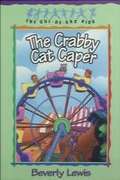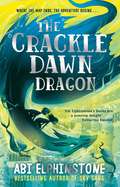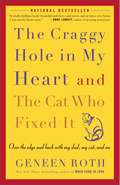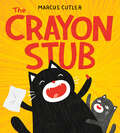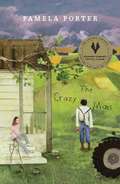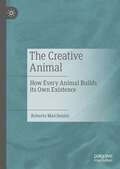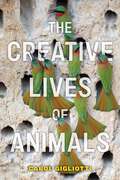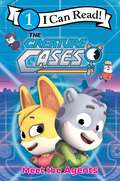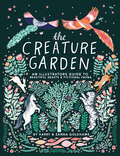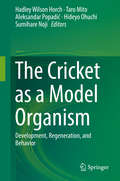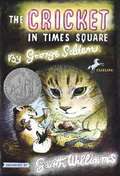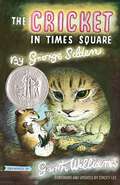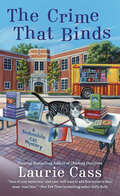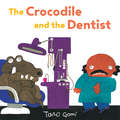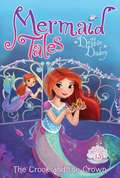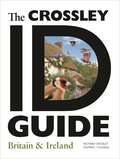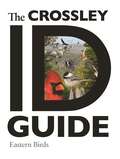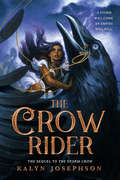- Table View
- List View
The Crab Alphabet Book
by Jerry PallottaWith his signature humor and amazing facts, best-selling author Jerry Pallotta offers a decapod for every letter of the alphabet.Meet dozens of crustaceans--and a few bonus animals--with engaging text and a laugh-out-loud narrative, from A (Arrow Crab) to E (exoskeleton) to I (Imocaris, a kind of fossil scientists believe to be the first crab on earth) to Z (Zebra Hermit Crabs, which have a hard covering on their legs and claws, but their body is soft). Readers of all ages will be entertained (and learning!) with every page turn.
The Crab on the Seashore (Animal Habitats)
by Jennifer ColdreyAnimal Habitats A Book for young readers featuring clear, authoritative text, glossary, and dozens of rich full-color photographs that vividly illustrate and explain animal life in natural habitats, showing how animals feed, defend themselves, struggle to survive, and reproduce. The text is short and loaded with information much of which is amazing! Many photographs are described and all have captions.
The Crabby Cat Caper
by Beverly LewisWhen Mister Whiskers vanishes just before the school carnival, can Dee Dee and her cul-de-sac friends capture the crazy cat?
The Crackledawn Dragon (The Unmapped Chronicles #3)
by Abi ElphinstoneMagic, adventure, and a whole new world is waiting to be discovered! The perfect series for adventurers aged 9+ and fans of Michelle Harrison, Piers Torday and Jamie Littler. The Unmapped Chronicles will not only leave children entertained, but will also empower them to battle climate change and environmental issues.Where the map ends, the adventure begins . . . 11-year-old Zebedee Bolt is on the run. Again. Only this time it&’s not the police who find him. It&’s an evil harpy called Morg. And when she hauls him into Crackledawn, an Unmapped kingdom that conjures sunlight for our world, Zeb discovers running away only gets you so far. When magic&’s involved, you&’ve got to pick a side. And though Zeb vowed he wouldn&’t trust anyone ever again, he didn&’t expect to stumble aboard The Kerfuffle, an enchanted boat belonging to a girl called Oonie and her talking chameleon, Mrs Fickletint. Suddenly, Zeb finds himself on a voyage complete with silver whales, fire krakens and underwater palaces. Can he muster up enough trust in others, and in magic, to summon a dragon, find the Ember Scroll and defeat Morg once and for all? This is a story about saving the world but it&’s also a story about trusting friends, and chameleons, even when kingdoms are falling apart. Praise for Abi Elphinstone!'Imaginative, adventurous and wonderful' Robin Stevens, author of A Murder Most Unladylike series 'The Unmapped Chronicles series is irresistible' Lauren St John, author of The White Giraffe 'Abi Elphinstone has created a complete world so believably and effortlessly, I can only marvel' Piers Torday, author of The Last Wild Trilogy 'Brimming with enchantment and adventure' Catherine Doyle, author of The Storm Keeper's Island &‘Abi Elphinstone is proving to be a worthy successor to C. S. Lewis&’ The TimesAlso by Abi Elphinstone:The Dreamsnatcher The Shadow Keeper The Night Spinner Sky Song Winter Magic (anthology)Everdark (World Book Day)RumblestarJungledrop
The Craggy Hole in My Heart and the Cat Who Fixed It: Over the Edge and Back with My Dad, My Cat, and Me
by Geneen RothIn this inspiring and joyous book,New York Times bestselling author Geneen Roth introduces her remarkable twenty-pound cat, Mister Blanche, and her beloved father, Bernard, as she takes readers deep into the story of how each finally taught her to love without reservation and accept that she might someday lose those whom she believed she couldn't live without. Told with warmth and wit, The Craggy Hole in My Heart and The Cat Who Fixed It is a poignant and funny story about how to live with love--and never live without it.
The Crayon Stub
by Marcus CutlerA hilarious picture book about an artistic kitty&’s search for inspiration—and the mischievous younger sibling who keeps getting in the way.Big Cat has a fresh new piece of paper, a box of big, beautiful crayons, and a dream: to create something TOTALLY SPECTACULAR and become WORLD FAMOUS! The only problem? All the crayons have gone missing except for one tiny red stub. What a disaster! And even if Big Cat could make something with the stub, what could possibly be spectacular enough to be worth drawing?Making matters worse, Big Cat has a younger sibling who keeps getting in the way. Little Cat seems less interested in making SPECTACULAR ART and more excited about . . . food, mostly. What's a feline in search of inspiration to do?
The Craziest Horse Show Ever (Riding Academy #8)
by Alison HartFour roommates at a boarding school with a riding program prepare for an upcoming horse show.
The Crazy Man
by Pamela PorterA poem about Emaline, a small girl who has to cope with a permanent disability and a broken family, since her father suffers from a mental illness.
The Creative Animal: How Every Animal Builds its Own Existence
by Roberto MarchesiniThis book deals with the theme of creativity in the animal world, conceived as a basic function for adapting to specific situations and as a source of innovations and inventions. Creativity is a fundamental resource for the individual who always has a leading role in conduct. To explain creativity, the book focuses on the concept of animal subjectivity, providing a new explanatory model of behavior capable of overcoming the image of the animal moved by automatisms. This model does not use consciousness as a necessary condition, but is based: 1) on affective components, such as behavioral motives, and 2) cognitive, as tools used by the subject to carry out his purposes. Particular attention is paid to the learning processes showing the subjective character of the experience. One topic addressed is the role of creativity in the evolution of living beings: how an invention, by modifying the niche characteristics, is able to change the selective pressures and the trajectory of phylogeny. Roberto Marchesini explains that creativity is a factor that is anything but rare or exceptional in the animal world—it constitutes a fundamental quality for many aspects of animal life.
The Creative Lives of Animals (Animals in Context)
by Carol GigliottiWinner of the 2023 Nautilus Book Award in the category of Animals & NatureThe surprising, fascinating, and remarkable ways that animals use creativity to thrive in their habitatsMost of us view animals through a very narrow lens, seeing only bits and pieces of beings that seem mostly peripheral to our lives. However, whether animals are building a shelter, seducing a mate, or inventing a new game, animals’ creative choices affect their social, cultural, and environmental worlds.The Creative Lives of Animals offers readers intimate glimpses of creativity in the lives of animals, from elephants to alligators to ants. Drawing on a growing body of scientific research, Carol Gigliotti unpacks examples of creativity demonstrated by animals through the lens of the creative process, an important component of creative behavior, and offers new thinking on animal intelligence, emotion, and self-awareness. With examples of the elaborate dams built by beavers or the lavishly decorated bowers of bowerbirds, Gigliotti provides a new perspective on animals as agents in their own lives, as valuable contributors to their world and ours, and as guides in understanding how creativity may contribute to conserving the natural world. Presenting a powerful argument for the importance of recognizing animals as individuals and as creators of a healthy, biodiverse world, this book offers insights into both the established and emerging questions about the creativity of animals.
The Creature Cases: Meet the Agents (I Can Read Level 1)
by Alexandra WestReady to meet the team? Join Kit Casey and Sam Snow, two top agents from the Covert League of Animal Detective Experts, as they introduce you to the world of CLADE!A hit Netflix show, The Creature Cases follows animal agents Kit Casey and Sam Snow as they solve mysteries in the animal kingdom using their top-secret spyware and sleuthing skills. This book is a Level One I Can Read, perfect for children learning to sound out words and sentences. Whether shared at home or in a classroom, the short sentences, familiar words, and simple concepts of Level One books support success for children eager to start reading on their own.
The Creature Garden: An Illustrator's Guide to Beautiful Beasts & Fictional Fauna
by Harry Goldhawk Zanna GoldhawkAn illustrator’s step-by-step sourcebook for drawing and painting fifty real and imagined creatures in a whimsical folk-art style. Husband-and-wife illustrator team Harry and Zanna Goldhawk, founders of Papio Press, teach you how to make vibrant drawings and paintings of these beautiful beasts and fictional fauna:Mammals, including big cats, wolves, sloths, and red pandasMarine life, including whales, sea dragons, narwhals, and giant Pacific octopiBirds, including peacocks, cranes, owls, and flamingosInsects, including butterflies, moths, bumblebees, and damselfliesMythical creatures, including mermaids, unicorns, dragons, phoenixes, centaurs, and hippogriffsand more!The Creature Garden begins with the basics, first instructing you on which tools to use, how to create patterns, the importance of keeping a sketchbook, and even avoiding comparison with other artists. The book then navigates through each illustration in a step-by-step manner that is manageable and easy to understand. Each project carefully guides you through each phase of the artistic process, from creating an outline to adding a realistic animal pattern.You’ll also learn how to draw botanical patterns from different environments—the garden, forest, jungle, and ocean—that enable you to surround your animal drawings with a natural environment. Full of lush warmth and fairy-tale wonder, The Creature Garden is a wonderful addition to the repertoire of both seasoned artists and novices alike.
The Cricket as a Model Organism
by Hadley Wilson Horch Taro Mito Aleksandar Popadić Hideyo Ohuchi Sumihare NojiThis book covers a broad range of topics about the cricket from its development, regeneration, physiology, nervous system, and behavior with remarkable recent updates by adapting the new, sophisticated molecular techniques including RNAi and other genome editing methods. It also provides detailed protocols on an array of topics and for basic experiments on the cricket. While the cricket has been one of the best models for neuroethological studies over the past 60 years, it has now become the most important system for studying basal hemimetabolous insects. The studies of Gryllus and related species of cricket will yield insight into evolutionary features that are not evident in other insect model systems, which mainly focus on holometabolous insects such as Drosophila, Tribolium, and Bombyx. Research on crickets and grasshoppers will be important for the development of pest-control strategies, given that some of the most notorious pests also belong to the order Orthoptera. At the same time, crickets possess an enormously high "food conversion efficiency", making them a potentially important food source for an ever-expanding human population. This volume provides a comprehensive source of information as well as potential new applications in pest management and food production of the cricket. It will inspire scientists in various disciplines to use the cricket model system to investigate interesting and innovative questions.
The Cricket in Times Square
by George SeldenAfter Chester, a cricket, arrives in the Times Square subway station, he takes up residence in a newsstand. Between escapades in New York City, Chester and four new friends manage to bring success to the almost bankrupt newsstand. <P><P> <b>Newbery Medal honors book</b>
The Cricket in Times Square: Revised and updated edition with foreword by Stacey Lee (Chester Cricket and His Friends #1)
by George SeldenAn updated version of the timeless children's classic featuring a business-savvy mouse, a kind alley cat, and a talented country cricket, featuring a new foreword and revisions by YA author Stacey Lee.Tucker is a streetwise city mouse. He thought he'd seen it all. But he's never met a cricket before, which really isn't surprising, because, along with his friend Harry Cat, Tucker lives in the very heart of New York City—the Times Square subway station.Chester Cricket never intended to leave his Connecticut meadow. He'd be there still if he hadn't followed the entrancing aroma of liverwurst right into someone's picnic basket. Now, like any tourist in the city, he wants to look around. And he could not have found two better guides—and friends—than Tucker and Harry. The trio have many adventures—from taking in the sights and sounds of Broadway to escaping a smoky fire.Chester makes a third friend, too. It is a boy, Mario, who rescues Chester from a dusty corner of the subway station and brings him to live in the safety of his parents' newsstand. He hopes at first to keep Chester as a pet, but Mario soon understands that the cricket is more than that. Because Chester has a hidden talent and no one—not even Chester himself—realizes that the little country cricket may just be able to teach even the toughest New Yorkers a thing or two.The Cricket in Times Square is George Selden at his best, and the new illustrations and interior images by Garth Williams make this edition a special treat.
The Crime That Binds (A Bookmobile Cat Mystery #10)
by Laurie CassLibrarian Minnie Hamilton and her rescue cat, Eddie, are ready to pin down a bank robber in the newest installment of the delightful Bookmobile Cat mystery series. Late March is prime reading weather in the small northern Michigan town of Chilson. Though snowfall and cloudy skies deter outdoor activities, life inside the bookmobile is warm and cheerful. But as Minnie and Eddie are making the rounds to deliver comforting reads, they see something strange: loyal bookmobile patron Ryan Anderson making a sudden u-turn and speeding away. When Minnie discovers the police want to question Ryan about a bank robbery and the death of a security guard, she realizes she&’s one of the only people who thinks Ryan isn&’t morally bankrupt. When an additional murder victim is discovered, the police immediately suspect her patron, but Minnie isn&’t convinced. And when she encounters Ryan hiding from the police, she decides to help him by investigating the crimes. Minnie and Eddie will have to fight tooth and claw to prove his innocence.
The Crocodile and the Dentist
by Taro GomiOh, it's time to go to the dentist! Crocodile has a toothache, but he's afraid of the dentist. The dentist wants to help, but he's afraid of Crocodile. Never fear! Bestselling author-illustrator Taro Gomi cleverly and humorously presents both sides of the story, as the crocodile and the dentist learn to be brave and face their fears—of what might happen in that dentist's chair and of each other!
The Crook and the Crown (Mermaid Tales #13)
by Debbie DadeyShelly Siren and her friends visit King Neptune's royal castle and attend their first ball in this Mermaid Tales adventure.Shelly, Echo, Kiki, and Pearl are spending their school vacation at Neptune's castle! Shelly's aunt, Queen Edwina, has invited the girls to stay for a whole week, and while they're there the girls can't wait to visit the Royal Orca Museum, see the Palace Library, ride seahorses, and maybe even attend a royal ball. Shelly is nervous about meeting her royal family, especially since she's never felt like a princess. But when she arrives at the castle, she is welcomed with curtsies, bows, and sea flowers. Queen Edwina even gives Shelly a sparkling tiara that she once wore as a young princess. Just as Shelly starts to relax and have fun, the tiara disappears and the girls have to find it before the queen finds out! The mergirls have a real mermystery on their fins! But will they be able to figure out who took the tiara before Shelly's royal visit turns into a royal disaster?
The Crossley ID Guide: Britain and Ireland (The Crossley ID Guides)
by Richard Crossley Dominic CouzensA groundbreaking and accessible field guide to the birds of Britain and IrelandThis guide is a celebration of the beauty of birds and the British and Irish countryside. Aimed at beginner and intermediate birders, yet suitable for all levels, this new volume in the groundbreaking Crossley ID Guide series is the most user-friendly guide to the birds of Britain and Ireland. Following The Crossley ID Guides' award-winning design, this book looks at all regularly occurring species in Britain and Ireland, and shows readers how to identify birds in their natural habitats using size, structure, shape, probability, and behavior—just like the experts do! Stunning images are accompanied by the colorful and compelling text of Dominic Couzens, one of Britain's leading nature writers.This unique book treats more than 300 species—all the regularly occurring birds likely to be encountered by observers--and the guide's attractive pages provide a real-life approach to bird identification. Beautiful, in-focus scenes present birds in various plumages and in lifelike poses set in identifiable British and Irish habitats. The plates also illustrate how a bird's appearance changes with distance. Organizing images in cohesive, easy-to-understand plates rather than as separate photographs, this book also sets itself apart by containing more images that demonstrate flight, behavior, habitat, and plumages than any other volume available. Not only is this field guide a reference book, it is also a spectacular teaching resource that makes it easy for nature enthusiasts to see and appreciate the big picture of bird identification.The most user-friendly guide to the birds of Britain and IrelandA close look at more than 300 regularly occurring speciesAward-winning Crossley ID Guide designLifelike images of birds from near to farA celebration of the British and Irish countrysideA teaching and field guide and essential referenceConcise and compelling text by Dominic Couzens and Richard Crossley
The Crossley ID Guide: Eastern Birds (The Crossley ID Guides)
by Richard CrossleyA revolution in birding and field guidesThis stunningly illustrated book from acclaimed birder and photographer Richard Crossley revolutionizes field guide design by providing the first real-life approach to identification. Whether you are a beginner, expert, or anywhere in between, The Crossley ID Guide will vastly improve your ability to identify birds.Unlike other guides, which provide isolated individual photographs or illustrations, this is the first book to feature large, lifelike scenes for each species. These scenes—640 in all—are composed from more than 10,000 of the author's images showing birds in a wide range of views--near and far, from different angles, in various plumages and behaviors, including flight, and in the habitat in which they live. These beautiful compositions show how a bird's appearance changes with distance, and give equal emphasis to characteristics experts use to identify birds: size, structure and shape, behavior, probability, and color. This is the first book to convey all of these features visually--in a single image--and to reinforce them with accurate, concise text. Each scene provides a wealth of detailed visual information that invites and rewards careful study, but the most important identification features can be grasped instantly by anyone.By making identification easier, more accurate, and more fun than ever before, The Crossley ID Guide will completely redefine how its users look at birds. Essential for all birders, it also promises to make new birders of many people who have despaired of using traditional guides.Revolutionary. This book changes field guide design to make you a better birderA picture says a thousand words. The most comprehensive guide: 640 stunning scenes created from 10,000 of the author's photographsReality birding. Lifelike in-focus scenes show birds in their habitats, from near and far, and in all plumages and behaviorsTeaching and reference. The first book to accurately portray all the key identification characteristics: size, shape, behavior, probability, and colorPractice makes perfect. An interactive learning experience to sharpen and test field identification skillsBird like the experts. The first book to simplify birding and help you understand how to bird like the bestAn interactive website—www.crossleybirds.com—includes expanded captions for the plates and species updates
The Crow Rider (Storm Crow #2)
by Kalyn JosephsonThe thrilling conclusion to the epic Storm Crow duology that follows a fallen princess as she tries to bring back the magical elemental crows taken from her people.Thia, her allies, and her crow, Res, are planning a rebellion to defeat Queen Razel and Illucia once and for all. Thia must convince the neighboring kingdoms to come to her aid, and Res's show of strength is the only thing that can help her.But so many obstacles stand in her way. Res excels at his training, until he loses control of his magic, harming Thia in the process. She is also pursued by Prince Ericen, heir to the Illucian throne and the one person she can't trust but can't seem to stay away from.As the rebel group prepares for war, Res's magic grows more unstable. Thia has to decide if she can rely on herself and their bond enough to lead the rebellion and become the crow rider she was meant to be.Praise for The Storm Crow:"Clashing kingdoms, thrilling action, and an imperfect heroine make this book a must-read."—ADRIENNE YOUNG, New York Times bestselling author of Sky in the Deep and The Girl the Sea Gave Back"Dragon fans should get ready for their next favorite creature. I loved this."—JESSICA CLUESS, author of A Shadow Bright and Burning
The Crow and the Pitcher
by Bill Greenhead Carrie Smith Sera Y. ReycraftCrow and Zebra are thirsty. They see a pitcher of water but can't get any to drink. Read this fable to learn from talking animals!
The Crow: The Third Book Of Pellinor
by Alison CroggonIn this third installment of Croggon's saga, the orphaned Hem is reunited with his lost sister, Maerad. When the forces of the Dark threaten, Hem discovers his own hidden gift and the role he must play in Maerad's quest to solve the Riddle of the Treesong.
The Cruelest Miles: The Heroic Story of Dogs and Men in a Race Against an Epidemic
by Laney Salisbury Gay Salisbury"A stirring tale of survival, thanks to man's best friend . . . reflects a transcendent understanding and impeccable research."--Seattle Times When a deadly diphtheria epidemic swept through Nome, Alaska, in 1925, the local doctor knew that without a fresh batch of antitoxin, his patients would die. The lifesaving serum was a thousand miles away, the port was icebound, and planes couldn't fly in blizzard conditions--only the dogs could make it. The heroic dash of dog teams across the Alaskan wilderness to Nome inspired the annual Iditarod Trail Sled Dog Race and immortalized Balto, the lead dog of the last team whose bronze statue still stands in New York City's Central Park. This is the greatest dog story, never fully told until now.


